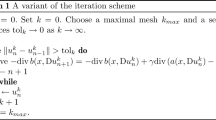Abstract
We consider the problem of finite-dimensional approximation for solutions of equations of the first kind and propose a modification of the projective scheme for solving ill-posed problems. We show that this modification allows one to obtain, for many classes of equations of the first kind, the best possible order of accuracy for the Tikhonov regularization by using an amount of information which is far less than for the standard projective technique.
Similar content being viewed by others
References
V. K. Ivanov, V. V. Vasin, and V. P. Tanana,Theory of Linear Ill-Posed Problems and Its Applications [in Russian] Nauka, Moscow 1978.
G. M. Vainikko,The Methods of Solving Linear Ill-Posed Problems in Hilbert Spaces [in Russian] Tartu University, Tartu 1982.
G. M. Vainikko, “The principle of residual for a certain class of regularized methods,”Zh. Vych. Mat. Mat. Fiz.,22, No. 3, 499–515 (1982).
R. Plato and G. Vainikko, “On the regularization of projection methods for solving ill-posed problems,”Numer. Math.,57, 63–70 (1990).
B. Alpert, G. Beylkin, R. Coifman, and V. Rohklin, “Wavelet-like bases for the fast solution of second-kind integral equations,”SIAMJ. Sci. Compute.,14, 159–184 (1993).
S. Heinrich, “Random approximation in numerical analysis,” in:Functional Analysis, New York (1994), pp. 123–171.
S. V. Pereverzev and C. C. Schapirov, “Information complexity of equations of the second kind with compact operators in Hilbert space,”J. Complexity,8, 176–202 (1992).
S. V. Pereverzev,Optimization of Projection Methods for Solving Ill-Posed Problems, Preprint No. 254, Univ. Kaiserslautern, Kaiserslautern (1994).
Rights and permissions
About this article
Cite this article
Solodkii, S.G. Complexity of projective methods for the solution of ill-posed problems. Ukr Math J 48, 1263–1275 (1996). https://doi.org/10.1007/BF02383872
Received:
Issue Date:
DOI: https://doi.org/10.1007/BF02383872



